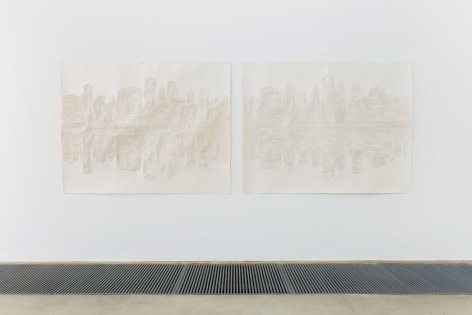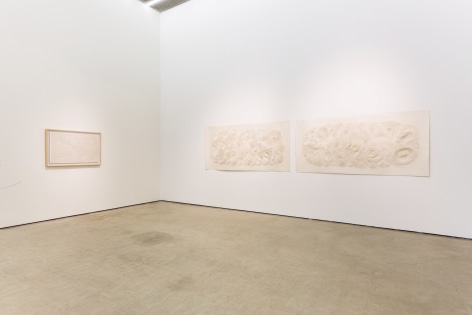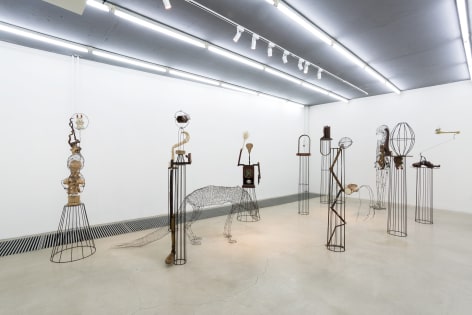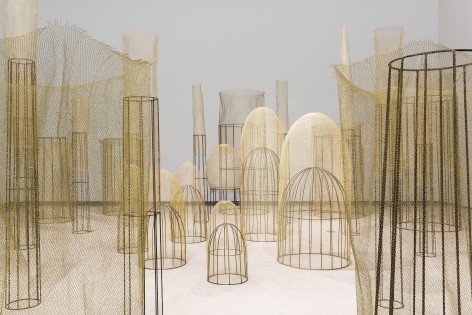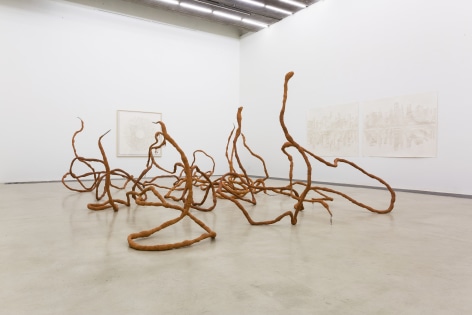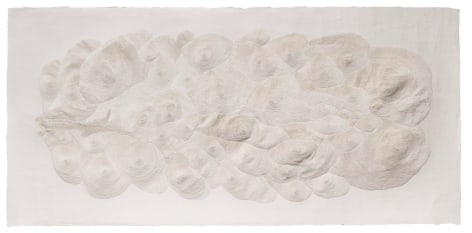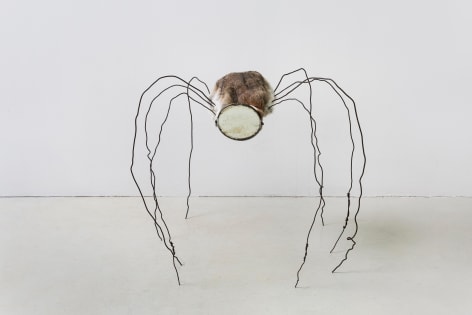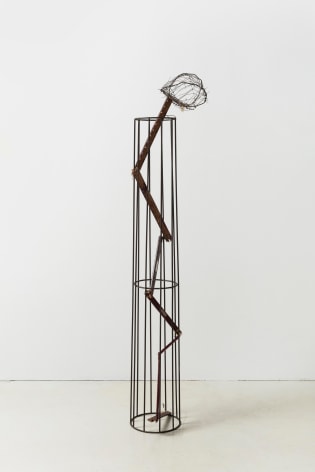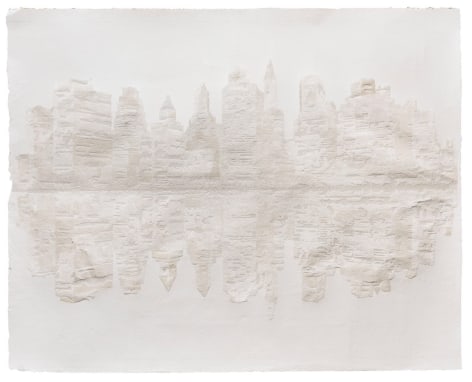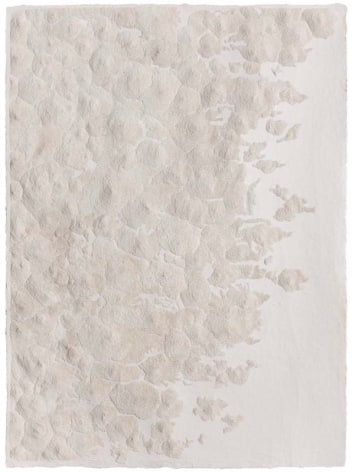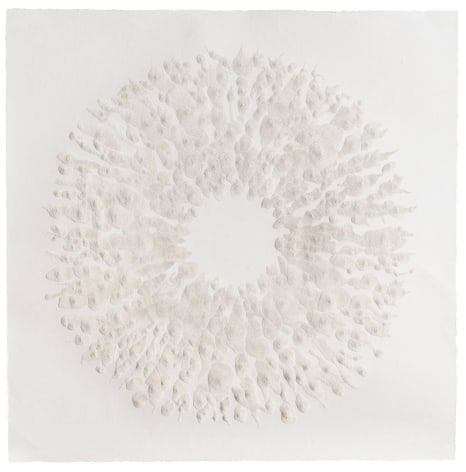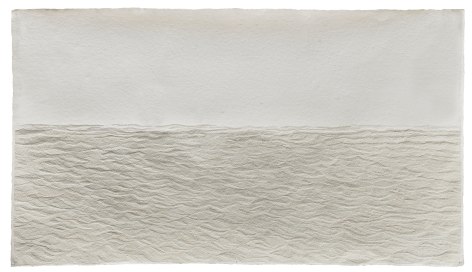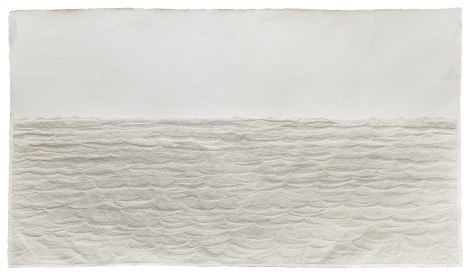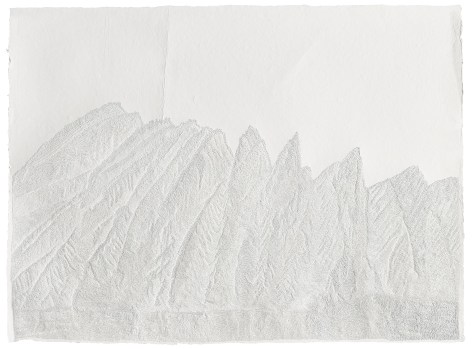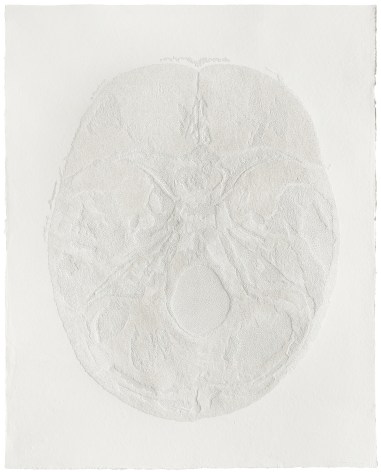Chambers Fine Art is pleased to announce the opening on April 22, 2017 of Limitless: New Works by Fu Xiaotong. Born in Shanxi in 1976, Fu Xiaotong received her BA in Fine Arts from the Tianjin Academy of Fine Arts, Tianjin in 2000. After working at the Institute of the Arts at North China University of Science and Technology, she received her MA in Fine Arts from the department of Experimental Art, China Central Academy of Fine Arts, Beijing in 2013. This will be her second exhibition at the gallery.
Fu Xiatong has achieved wide acclaim for her remarkable works on thick sheets of hand-made Xuan paper perforated with a needle until images of subjects such as mountain ranges and powerful waves emerge from the accumulation of holes so skillfully created by her mastery of her innovative working process. In her latest paper works a more varied thematic content ranging from female breasts to cellular structures and a scull emerges from hundreds of thousands of pinpricks. Less well-known although an essential aspect of her practice is her sculpture, dramatically announced in the exhibition Land of Serenity at Chambers Fine Art in Beijing by the inclusion of Void, a life-size representation of an elephant created from metallic wire. Not quite finished – the tail and trunk were not completed – the massive form quivered at the slightest touch, an indication of her simultaneous embrace of the third dimension and rejection of its expression as sculptural mass.
In Limitless, Fu Xiaotong’s sculpture takes the foreground while a series of works on Xuan paper explores her development of a new range of imagery. Limitless consists of a group of 32 individual sculptural forms constructed from wire, metallic mesh, and a wide range of found objects including bones, ceramic ornaments, legs of tables or chairs, shoe-trees etc. Writing of this enthusiasm in 2013, she noted that “I have used a lot of antiquated readymade things and some very ordinary daily stuff in my works. I transform them and combine the readymade things with various materials such as clay, flax, leather and so on. These materials contain the ideology and spirit lost in the progress of human civilization. My purpose is not to present a certain historical event but to integrate the ancient intellects, rites, beliefs, and other human experiences and echoes of memories in different time hierarchies into an eternal now.”
Each slightly above life-size, the assemblages are primarily vertical in format although there are exceptions such as the Mirrored Spider. There is a wide range in the degree of elaboration to which the wire framework is subjected. In some such as Dragon Egg the sculptural interest derives from the contrast between the spindly pedestal-like form constructed from metal wire and an oval form made from metallic mesh, the egg referred to in the title. Likewise Mirrored Spider is constructed from a limited range of materials and is relatively direct in its representation of an arachnid. For the most part, however, the fragile framework hosts a dizzying array of found objects, many of them apparently fetishes that have long lost their supernatural power. Examples include Moon Rabbit and the sinister Father which is constructed from iron, wood, linen, newspaper, and soil.
Assemblage, the incorporation of material and objects from the world in which we live, has been one of the primary means of sculptural expression since the early years of the twentieth century. Installations now routinely employ vast quantities of unclassifiable materials. In the selection of materials used in her assemblages Fu Xiaotong ranges at least as widely as any of her precursors but she uses them sparingly and frequently with an unexpected sense of humor. Another defining characteristic of the 32 figures that constitute Limitless is their apparent fragility. The abundant use of wire in their construction imparts a sense of instability and derives ultimately from Alexander Calder’s celebrated wire sculptures of the 1920s and early 1930s. Also hovering in the background is the poetic Italian sculptor Fausto Melotti whose linear sculptures are notable for their grace and lack of physical substance.
Distinguishing Fu Xiaotong from any of her spiritual forebears, however, is her belief that by incorporating fragments from the “real” world in her sculptures, she is delving deep into psychological and spiritual realities. Referring to the Current exhibition, she has noted that “Fragments of memories are like the universe, always spinning. Like a bipolar patient, I have to use labor-intensive methods to resist fear. Puncturing thousands of holes on smooth paper, it piles up like wrinkled skin. Using recycled copper wire to braid a hexagonal snake motif, and rusty iron wire to tie together different kinds of waste material - from ruined architecture to broken steel bars, all are evidence of the circle of destruction and re-creation in human society. This series of works becomes a comprehensive revelation of the nature of physical reality and ideologies that exist beyond time and place. It is a metaphor for “nature or the “life-cycle.”
前波画廊诚挚地宣布《永无止境:付小桐新作》将于2017年4月22开幕。付小桐于1976年出生于山西,2000年在天津美术学院获得本科学位,后任教于华北理工大学艺术学院,并于2013年获中央美术学院实验艺术系硕士学位。此次将是她在本画廊的第二次个展。
付小桐与众不同的纸上作品获得了广泛的赞誉。她以精湛的技术在较厚的手工宣纸上用针刺孔,这些针孔日积月累直到呈现出山脉和惊涛骇浪的图像。她在最新的纸上作品中尝试了不同的主题,从乳房、细胞组织,到人的头盖骨,都由成千上万个孔扎成。相比之下,付小桐的雕塑作品并没有纸上作品闻名,但也是其艺术创作中的重要组成部分。两年前北京前波画廊的展览《寂静之地》便隆重介绍了其雕塑创作,作品《空象》是一个由金属丝制作的实际大小的小象。艺术家没有完整编织它的腿和尾巴,稍微的触碰都会使这个硕大的形态左摇右晃,显示出付小桐一方面对三维立体充满了兴趣,另一方面又摒弃了雕塑的固态表现手法。
在展览《永无止境》中,付小桐的雕塑作品成为了主角,同时一系列宣纸作品展现出她最新尝试的扎法和图像。同名作品《永无止境》由32件雕塑组成,其中每一件由金属丝、金属网,以及骨头、瓷片、桌子腿、椅子腿、鞋楦等一系列拾得材料组成。付小桐在2013年写到:“我的作品运用了许多古旧的现成品,以及极为普通的日常物品,对其进行改造,把现成品和各种材料如泥土、麻丝、牛皮等结合在一起,这些材料包含了人类文明进程中失落的意识形态和淳朴精神。其目的并不是要表现某一特定的历史事件,而是希望能将往昔古老的理智,远古仪式、信仰等不同时间层次的人类经验和记忆的回声,融汇进一个永恒的现在。”
展览中的每件雕塑作品比真人稍大一些,除了《镜面蜘蛛》等例外,大多呈现出立式的形态。这些作品的金属构架的精致程度各不相同。在作品《龙蛋》中,由金属丝构建的纤细底座与由金属网制作的椭圆形态——龙蛋——形成对比。同样,《镜面蜘蛛》由有限的材料制成,相对直观地描述了一个蛛形纲动物。然而在大多数的作品中,脆弱的构架支撑、包容了各式各样、令人炫目的物件,那些早已失去灵性的灵物。例如作品《月兔》和《父亲》由铁、木、麻绳、报纸和泥土等制成。
集合艺术,即用我们生活中的现成材料和物品组装成作品,自20世纪初期以来便成为了一种主要雕塑表现手法。当今的装置作品采用很多难以归类的材料。付小桐在其组装作品中采用的材料种类繁多,不亚于集合艺术的前辈们。然而付小桐对材料的运用十分谨慎,也常常带有意想不到的幽默。《永无止境》这32件雕塑的另一特征是它们的脆弱。对金属丝的大量使用流露出一种不稳定的感觉,也是受了上世纪二三十年代著名雕塑家亚历山大·考尔德的启发。同时也令人联想到富有诗意的意大利雕塑家福斯托·梅洛蒂,其不具实体感的线性雕塑以优雅的形态著称。
然而在意识形态上,付小桐与前辈们不同,她认为通过在雕塑作品中植入现实生活中的碎片,可以深入探索心理与精神世界。关于本次展览,她阐述道:“记忆的碎片如浩瀚宇宙,飞速旋转。就像一个多基因叠加的精神分裂症患者,它触使我不得不用密集的劳作方式来抵抗恐惧。在平整的纸上扎出千万个针孔,堆积如褶的皮肤;用细铜丝反复编制出精致的六边形蛇纹;用生锈的铁丝紧紧地把废弃的物品捆绑在一起;从毁坏的建筑里拆卸弯曲的旧钢筋,作为一次次人类毁灭与重建的见证物等等。这一系列作品成为物质与意识跨越时空的一种“综合再现”;一种 “自然”或“生命轮回”的象征物。”

